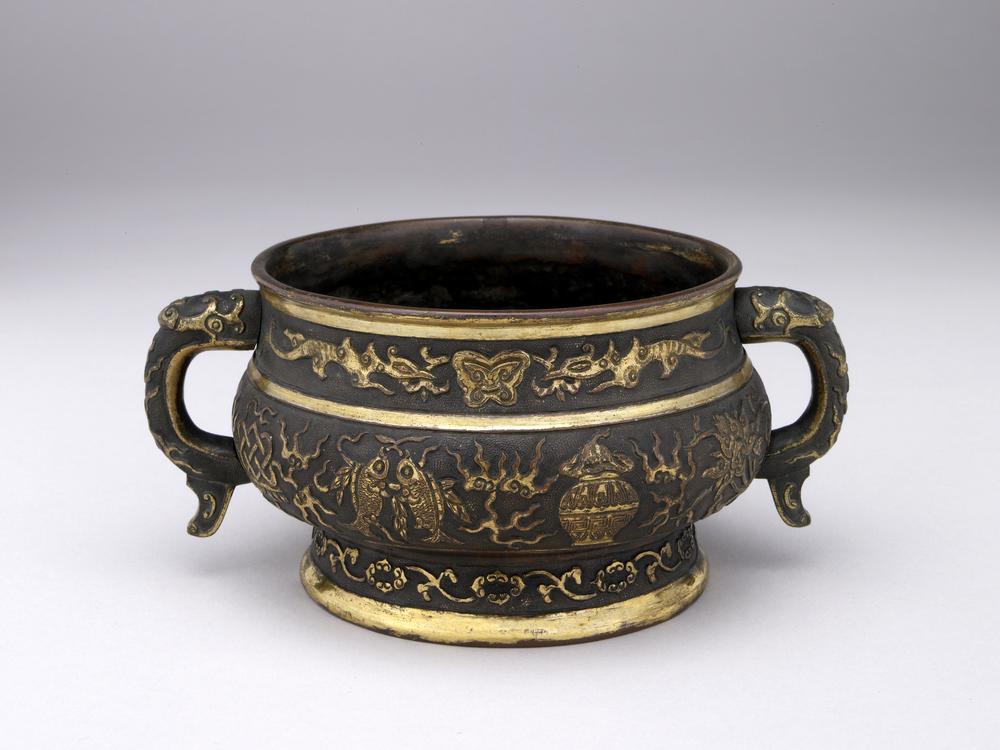Period:Five Dynasties and Ten Kingdoms Production date:10thC(late) (circa)
Materials:silk, 絲綢 (Chinese),
Technique:painted
Subjects:bodhisattva religious object sun/moon 菩薩 (Chinese) 法器 (Chinese) 供養人 (Chinese) 日/月 (Chinese)
Dimensions:Height: 84.40 centimetres Width: 61.70 centimetres
Description:
Painting of six-armed Avalokiteśvara seated behind an altar. The two upper arms carry the Sun and Moon. The two central arms are in the gesture of discussion (vitarka-mudra), while the lower ones hold a rosary and a medicine bottle. In the side scenes are the Six Perils from which Avalokiteśvara rescues the believer. In the lower part, kneeling donor figures flank a blank cartouche. Ink and colour on silk.
IMG
![图片[1]-painting; 繪畫(Chinese) BM-1919-0101-0.2-China Archive](https://chinaarchive.net/Five Dynasties and Ten Kingdoms/Paintings/mid_00324113_001.jpg)
![图片[2]-painting; 繪畫(Chinese) BM-1919-0101-0.2-China Archive](https://chinaarchive.net/Five Dynasties and Ten Kingdoms/Paintings/mid_RFC2812.jpg)
![图片[3]-painting; 繪畫(Chinese) BM-1919-0101-0.2-China Archive](https://chinaarchive.net/Five Dynasties and Ten Kingdoms/Paintings/mid_RFC2812_top.jpg)
![图片[4]-painting; 繪畫(Chinese) BM-1919-0101-0.2-China Archive](https://chinaarchive.net/Five Dynasties and Ten Kingdoms/Paintings/mid_RFC2812_bottom.jpg)
Comments:EnglishFrom Whitfield 1983:This painting can be taken as typical of votive paintings of the mid-to late tenth century. It is very well preserved, though without a border or an inscription on the large central cartouche.Avalokitesvara, seated on a lotus throne with an altar before him, is in six-armed form. Two arms, upraised, carry the sun and the moon, with a three-legged bird and a tree within them. The two central arms are in vitarka-mudra, while the two lowest hold the rosary and medicine bottle. A dark green sash winds about them all. To either side, six of the Perils from which Guanyin would rescue the believer are shown (Pls. 18-2, 18-3), with landscape settings where necessary, as for the man being pushed off a high cliff, or the one below that scene in which a prisoner kneels in the doorway of a cell with fetters beside him. Such representations are found not only in paintings on silk (see also Pls.21, 25) but in small votive booklets dedicated to Guanyin, such as that in the British Library (see Pl. 65, Figs. 92-95) where the representation, for instance, of peril by fire is almost identical to that shown here.The painting has a patterned appearance due to the use of very few colours apart from black ink, which is used to good effect. The dark green already mentioned serves for grassy slopes, leaves and stems, as well as the scarves; orange-red serves for flames, robes, accessories like the fetters and cangue of the prisoner, flowers and cartouches; a light purple wash is used for schematic shading of the face and torso of the Bodhisattva, and for flowers and for the petals of his throne. Bright yellow represents golden ornaments, cartouches and the lining of one of the donor’s robes. The regular alternation of few colours recalls the orderly use of colours to achieve a repeating pattern in the depictions of the Thousand Buddhas on the walls of the Mogao caves at Dunhuang. ChineseFrom Whitfield 1983:此畫被看作是10世紀中葉至末期捐赠畫的代表作品。下段中央的題記欄仍是空白的,絹邊雖已缺失,繪畫部分的保存狀態卻良好。六臂觀音坐在蓮華座上,前面放著供物台。上舉的兩手托著日月,日月中有各自象徵的三足鳥和樹。中央的兩手結說法印,下方的兩手則分別挂著數珠和淨瓶。所有的手上都纏繞著暗綠色的天衣。兩側表現觀音救助信徒於諸難中的六難(參照圖18-2、18-3)。各場面中插入必要的相應背景,如男人從斷崖上被推下的場面,其下面是囚人身旁放著腳銬坐在大牢門口的場面,背景描繪山岩。這種樣式的圖,不僅絹繪的其它《法華經普門品變相圖》(參照圖21、25)中,在大英圖書館收藏的表現觀音或地藏功德的小冊子(參照圖65、Figs.92~95)中也可見到。其中,本圖中火難的場面與圖21中的情況非常相似。此畫的墨線使用極有成效,但被色數所限,略有圖案的感覺。觀音的天衣、草叢覆蓋的土坡以及繪成華蓋狀上的花枝的莖、葉等均用同樣的暗綠色。另一方面,火焰、觀音的裳、囚人的枷和腳銬、花瓣、長方形題箋框等都用同樣的赤橙色。而觀音的臉部和上半身是圖式化的暈染。花瓣和台座蓮瓣的部分等使用同樣的淡紫色。金的裝飾物和長方形題箋框、男供養人像的衣服裏子等則用鮮豔的黃色。幾種顔色交替使用,使人想起敦煌莫高窟壁畫中描繪千佛時有秩序地使用各種顔色以構成的重復圖案。
Materials:silk, 絲綢 (Chinese),
Technique:painted
Subjects:bodhisattva religious object sun/moon 菩薩 (Chinese) 法器 (Chinese) 供養人 (Chinese) 日/月 (Chinese)
Dimensions:Height: 84.40 centimetres Width: 61.70 centimetres
Description:
Painting of six-armed Avalokiteśvara seated behind an altar. The two upper arms carry the Sun and Moon. The two central arms are in the gesture of discussion (vitarka-mudra), while the lower ones hold a rosary and a medicine bottle. In the side scenes are the Six Perils from which Avalokiteśvara rescues the believer. In the lower part, kneeling donor figures flank a blank cartouche. Ink and colour on silk.
IMG
![图片[1]-painting; 繪畫(Chinese) BM-1919-0101-0.2-China Archive](https://chinaarchive.net/Five Dynasties and Ten Kingdoms/Paintings/mid_00324113_001.jpg)
![图片[2]-painting; 繪畫(Chinese) BM-1919-0101-0.2-China Archive](https://chinaarchive.net/Five Dynasties and Ten Kingdoms/Paintings/mid_RFC2812.jpg)
![图片[3]-painting; 繪畫(Chinese) BM-1919-0101-0.2-China Archive](https://chinaarchive.net/Five Dynasties and Ten Kingdoms/Paintings/mid_RFC2812_top.jpg)
![图片[4]-painting; 繪畫(Chinese) BM-1919-0101-0.2-China Archive](https://chinaarchive.net/Five Dynasties and Ten Kingdoms/Paintings/mid_RFC2812_bottom.jpg)
Comments:EnglishFrom Whitfield 1983:This painting can be taken as typical of votive paintings of the mid-to late tenth century. It is very well preserved, though without a border or an inscription on the large central cartouche.Avalokitesvara, seated on a lotus throne with an altar before him, is in six-armed form. Two arms, upraised, carry the sun and the moon, with a three-legged bird and a tree within them. The two central arms are in vitarka-mudra, while the two lowest hold the rosary and medicine bottle. A dark green sash winds about them all. To either side, six of the Perils from which Guanyin would rescue the believer are shown (Pls. 18-2, 18-3), with landscape settings where necessary, as for the man being pushed off a high cliff, or the one below that scene in which a prisoner kneels in the doorway of a cell with fetters beside him. Such representations are found not only in paintings on silk (see also Pls.21, 25) but in small votive booklets dedicated to Guanyin, such as that in the British Library (see Pl. 65, Figs. 92-95) where the representation, for instance, of peril by fire is almost identical to that shown here.The painting has a patterned appearance due to the use of very few colours apart from black ink, which is used to good effect. The dark green already mentioned serves for grassy slopes, leaves and stems, as well as the scarves; orange-red serves for flames, robes, accessories like the fetters and cangue of the prisoner, flowers and cartouches; a light purple wash is used for schematic shading of the face and torso of the Bodhisattva, and for flowers and for the petals of his throne. Bright yellow represents golden ornaments, cartouches and the lining of one of the donor’s robes. The regular alternation of few colours recalls the orderly use of colours to achieve a repeating pattern in the depictions of the Thousand Buddhas on the walls of the Mogao caves at Dunhuang. ChineseFrom Whitfield 1983:此畫被看作是10世紀中葉至末期捐赠畫的代表作品。下段中央的題記欄仍是空白的,絹邊雖已缺失,繪畫部分的保存狀態卻良好。六臂觀音坐在蓮華座上,前面放著供物台。上舉的兩手托著日月,日月中有各自象徵的三足鳥和樹。中央的兩手結說法印,下方的兩手則分別挂著數珠和淨瓶。所有的手上都纏繞著暗綠色的天衣。兩側表現觀音救助信徒於諸難中的六難(參照圖18-2、18-3)。各場面中插入必要的相應背景,如男人從斷崖上被推下的場面,其下面是囚人身旁放著腳銬坐在大牢門口的場面,背景描繪山岩。這種樣式的圖,不僅絹繪的其它《法華經普門品變相圖》(參照圖21、25)中,在大英圖書館收藏的表現觀音或地藏功德的小冊子(參照圖65、Figs.92~95)中也可見到。其中,本圖中火難的場面與圖21中的情況非常相似。此畫的墨線使用極有成效,但被色數所限,略有圖案的感覺。觀音的天衣、草叢覆蓋的土坡以及繪成華蓋狀上的花枝的莖、葉等均用同樣的暗綠色。另一方面,火焰、觀音的裳、囚人的枷和腳銬、花瓣、長方形題箋框等都用同樣的赤橙色。而觀音的臉部和上半身是圖式化的暈染。花瓣和台座蓮瓣的部分等使用同樣的淡紫色。金的裝飾物和長方形題箋框、男供養人像的衣服裏子等則用鮮豔的黃色。幾種顔色交替使用,使人想起敦煌莫高窟壁畫中描繪千佛時有秩序地使用各種顔色以構成的重復圖案。
© Copyright
The copyright of the article belongs to the author, please keep the original link for reprinting.
THE END
![[Qing Dynasty] British female painter—Elizabeth Keith, using woodblock prints to record China from the late Qing Dynasty to the early Republic of China—1915-China Archive](https://chinaarchive.net/wp-content/uploads/2022/11/image-191x300.png)




